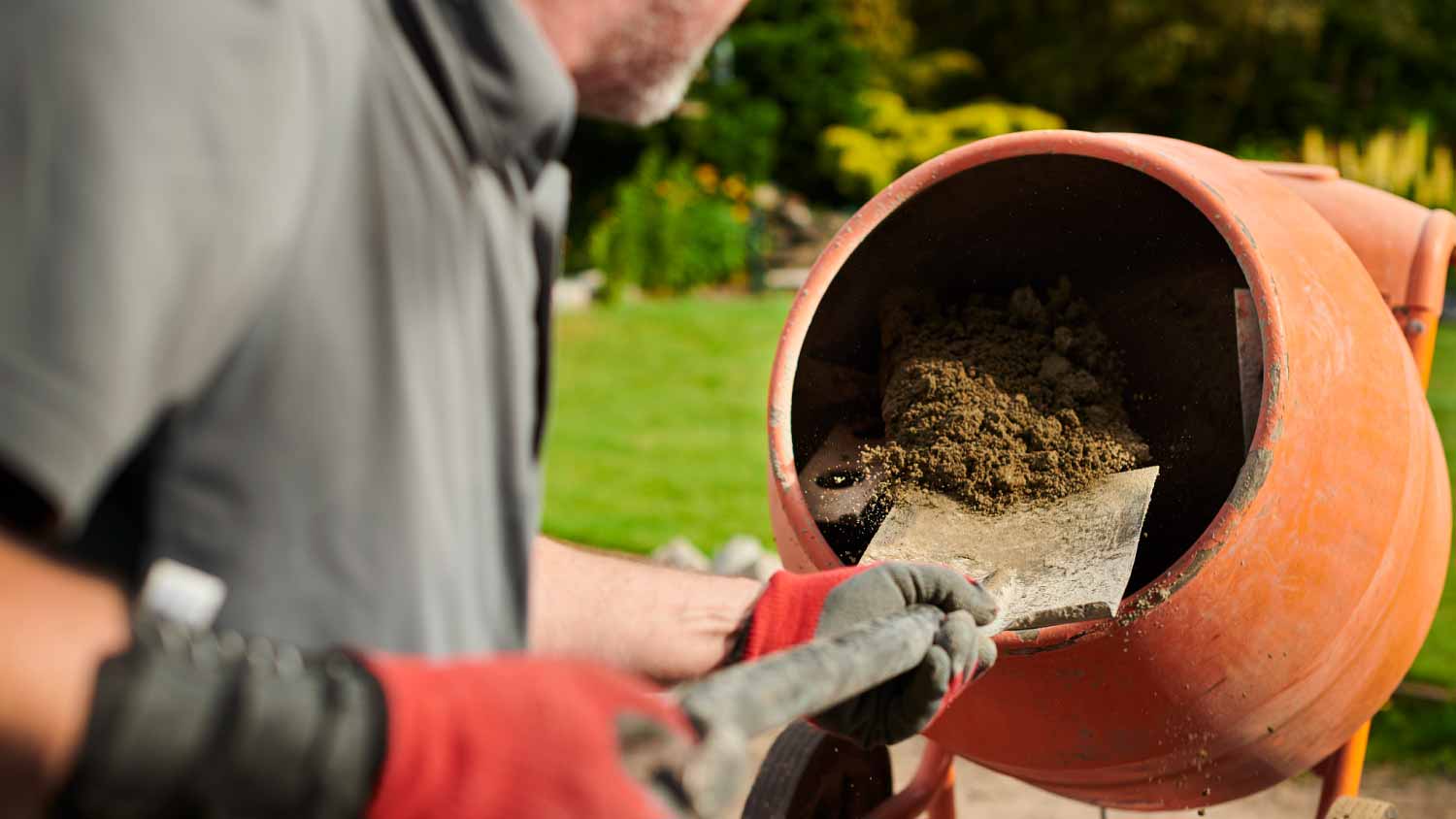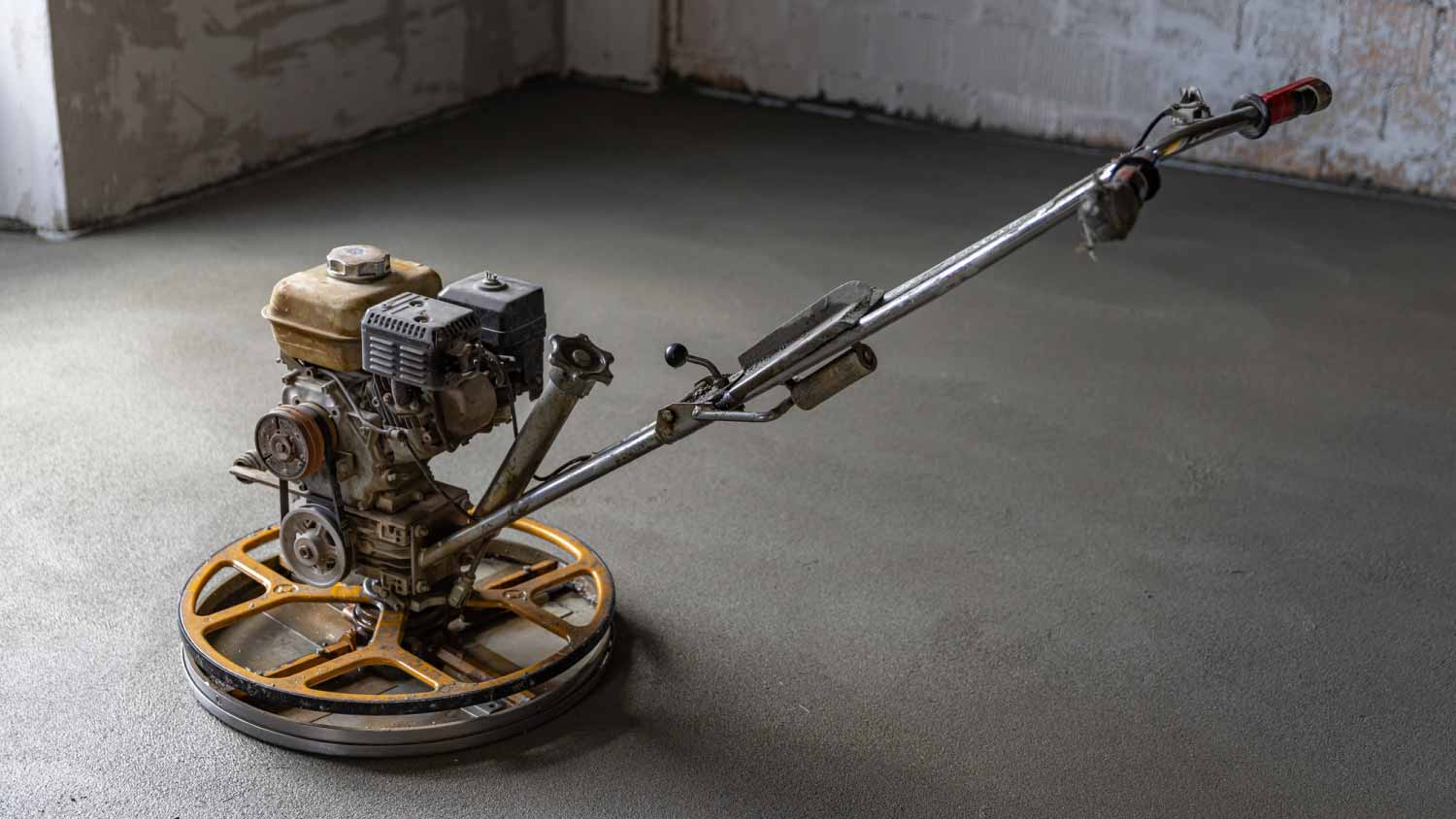Ultimate Concrete Tools List for Your Home Projects
Make DIY concrete work a breeze with these tools


Working with concrete can be intimidating if you’ve never poured, resurfaced, demolished, or cut it before. With the right tools, though, you should be able to tackle your project with some patience and practice. To get started in the right direction, use this concrete tools list to ensure you’re fully prepared before diving into DIYing.
Always put on protective clothing before working with concrete, as it can cause chemical burns. Make sure to wear long sleeves, pants, waterproof gloves, safety goggles, and a face mask.
Tools for Installing Concrete

Installing concrete involves building molds or concrete forms, mixing concrete, pouring it into the mold, and then leveling it off and creating a suitable surface. You should consider investing in a few tools that can help make your job a lot easier.
Concrete mixer: If you’re pouring a small amount of concrete, you can mix it in a wheelbarrow or 5-gallon bucket, but for larger projects, you’ll save time and energy investing in a concrete mixer to mix and pour your concrete.
5-gallon bucket: For small projects, you can mix the concrete you need in a 5-gallon bucket with a shovel or trowel.
Wheelbarrow: For mid-sized concrete projects, like pouring footers for a pergola or another landscaping feature, you can mix your concrete in a wheelbarrow. This is also helpful for pouring your concrete exactly where you need it.
Shovel: Shovels are always handy for mixing concrete and for precise placement of wet concrete inside your concrete form.
Concrete vibrator: Concrete loses strength if air bubbles are trapped inside when it cures. You can use a concrete vibrator to agitate the concrete or mold to release air bubbles.
Metal rake: You can use a metal rake upside down to smooth out the surface of your concrete before it cures. You’d want to use a screed board for general smoothing and leveling, but a rake is good for spot smoothing.
Screed: A screed is a long, perfectly straight board that you rest on your concrete forms on either side of the slab. You shift it back and forth over your concrete surface to level everything out. Your screed should be at least a foot longer than the longest length of your slab.
Concrete float: A concrete float is a large, flat piece of material on a long stick that allows you to smooth out the concrete slab while standing outside the perimeter. The float can be wood, magnesium, or another metal.
Trowel: A trowel is a small, handheld tool that you can use for spot smoothing and concrete troweling. It works similarly to a float but on a smaller scale.
Concrete edging tool: A concrete edging tool is similar to a trowel but has a curved design that lets you create curved edges on your concrete.
We should mention that installing concrete forms, pouring concrete, and creating a smooth, level surface is time-consuming, physically demanding, and challenging to get right. Consider contacting a concrete company near you for help, especially with larger projects.
Tools for Cutting Concrete
You might also want to pick up some tools for cutting concrete, which can be helpful for concrete repair or demolition. You can choose from various powered saws and other tools, including manual ones. Before you use any of these, make sure you know how to cut concrete using your preferred tool and wear a respirator, as concrete dust can irritate your lungs.
Angle grinder: An angle grinder is a powered tool that spins a cutting disc to cut through a wide variety of materials. You’ll need a masonry or concrete blade to cut concrete. Angle grinders are ideal for making small cuts quickly, like if you need to cut concrete blocks, but they’re not ideal for larger cuts.
Circular saw: A circular saw is a handheld power saw with a flat guide that makes cutting straight lines easier than with an angle grinder. You’ll need a masonry blade for this, as well. Circular saws are great for cutting long, straight lines through thin slabs.
Walk-behind saw: A walk-behind saw also has a flat guide to make cutting long, straight lines easier. Equipped with a masonry blade, you can cut deeper than you could with a circular saw, making this a good option for cutting through thicker slabs for concrete repair or removal.
Hammer drill: A hammer drill is another power tool that rapidly hammers a masonry chisel bit into the concrete, similar to a handheld jackhammer. The cut with a hammer drill will be less precise than with a saw.
Hammer and chisel: You can also cut concrete manually using a hammer and chisel. Given how slow this method is, it’s best for small projects, like cutting a small number of concrete pavers. This method lets you get precise cuts, so it’s a good option for detailed work.
Cutting concrete can also be challenging and potentially dangerous, so you may want to consider hiring a professional, especially for detailed or decorative cuts.
Tools for Repairing Concrete

Concrete is a highly durable material, but you’ll need to repair it occasionally. When that need arises, you might want to consider investing in some concrete repair tools.
Pressure washer: You can use a pressure washer to clean concrete surfaces for routine maintenance or before patchwork to get better adhesion.
Wire brush: You can use a wire brush to remove loose concrete before crack sealing or resurfacing it.
Router or angle grinder: A router or angle grinder with a masonry bit or blade can cut along concrete cracks to get a larger surface for your sealant or mortar to adhere to.
Concrete grinder or sander: A concrete grinder or sander is great for resurfacing old concrete before sealing it. You can invest in a handheld grinder or sander or a walk-behind grinder or sander for larger projects.
Tools for Demolishing Concrete
Finally, you have tools for demolishing concrete, which you can use to remove old slabs, concrete steps, and more before replacing them.
Sledgehammer: A sledgehammer is a large hammer with a heavy head that you can use to break through concrete slabs to make hauling away the concrete easier.
Jackhammer: A jackhammer is a power tool that repeatedly thrusts a chisel bit into a concrete surface to break it up rapidly. This might be overkill for smaller projects, but it’s much faster than a sledgehammer for larger ones.
Concrete saw: A concrete saw will cut through concrete to make removal easier. You can choose from a few options: an angle grinder, a circular saw with a masonry wheel, or a walk-behind concrete saw.
Concrete breaker bar: A breaker bar is like a long chisel that you can drive into concrete with a sledgehammer to break it up. It makes breaking thick or reinforced slabs much easier than a sledgehammer alone.
Bolt cutters: Bolt cutters cut through thick metal material, making cutting through wire mesh or rebar in your concrete easier.
Hacksaw: A hacksaw has a blade designed to cut through metal, so it’s an alternative to bolt cutters for cutting through rebar.





- Can You Pour New Concrete Over Existing Concrete?
- How to Dispose of Concrete 5 Ways
- How to Cut Concrete for All Skill Levels
- Who Repairs Concrete Steps?
- Who Do I Call to Repair Concrete?
- 6 Concrete Maintenance Tips to Extend Its Longevity
- How to Break Up and Remove Concrete
- 9 Tips and Tricks for Beginners Working With Concrete
- 17 Types of Concrete and How They’re Used
- How to Clean Concrete Indoors and Outdoors











